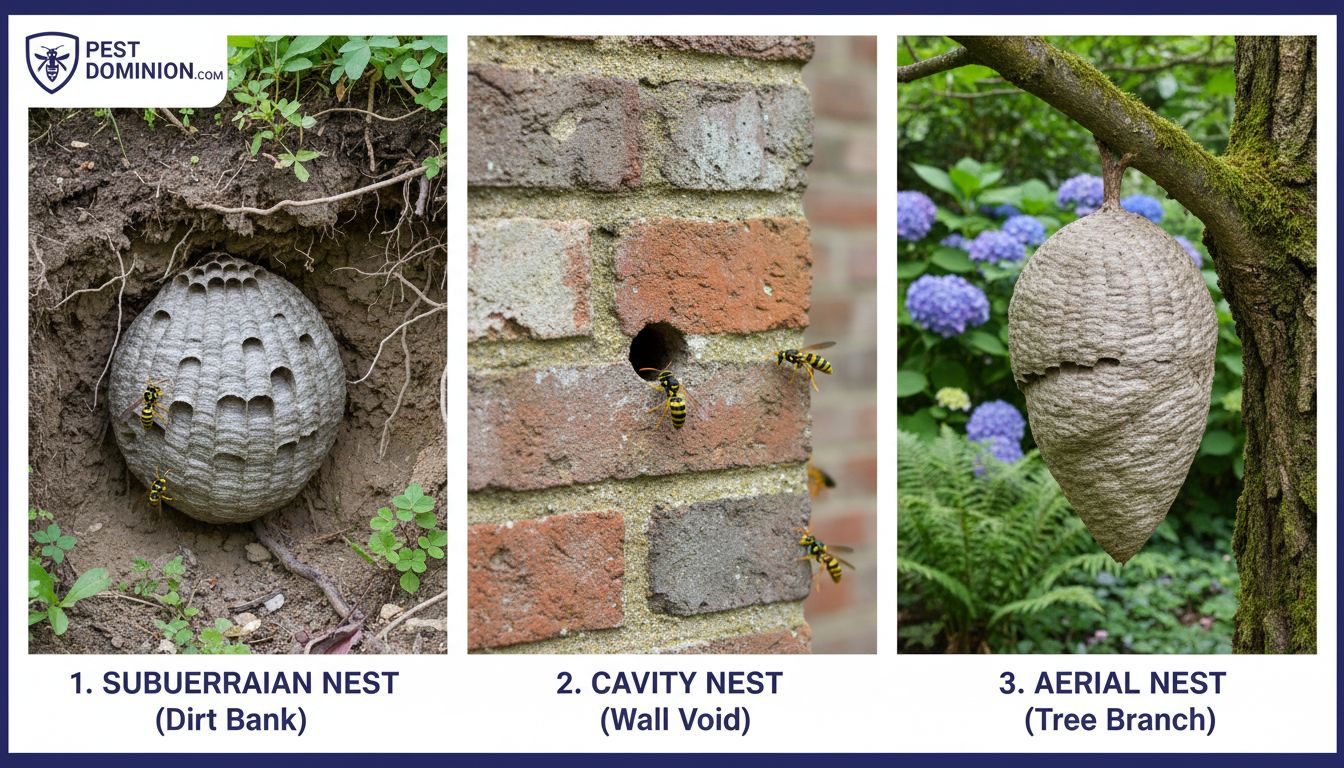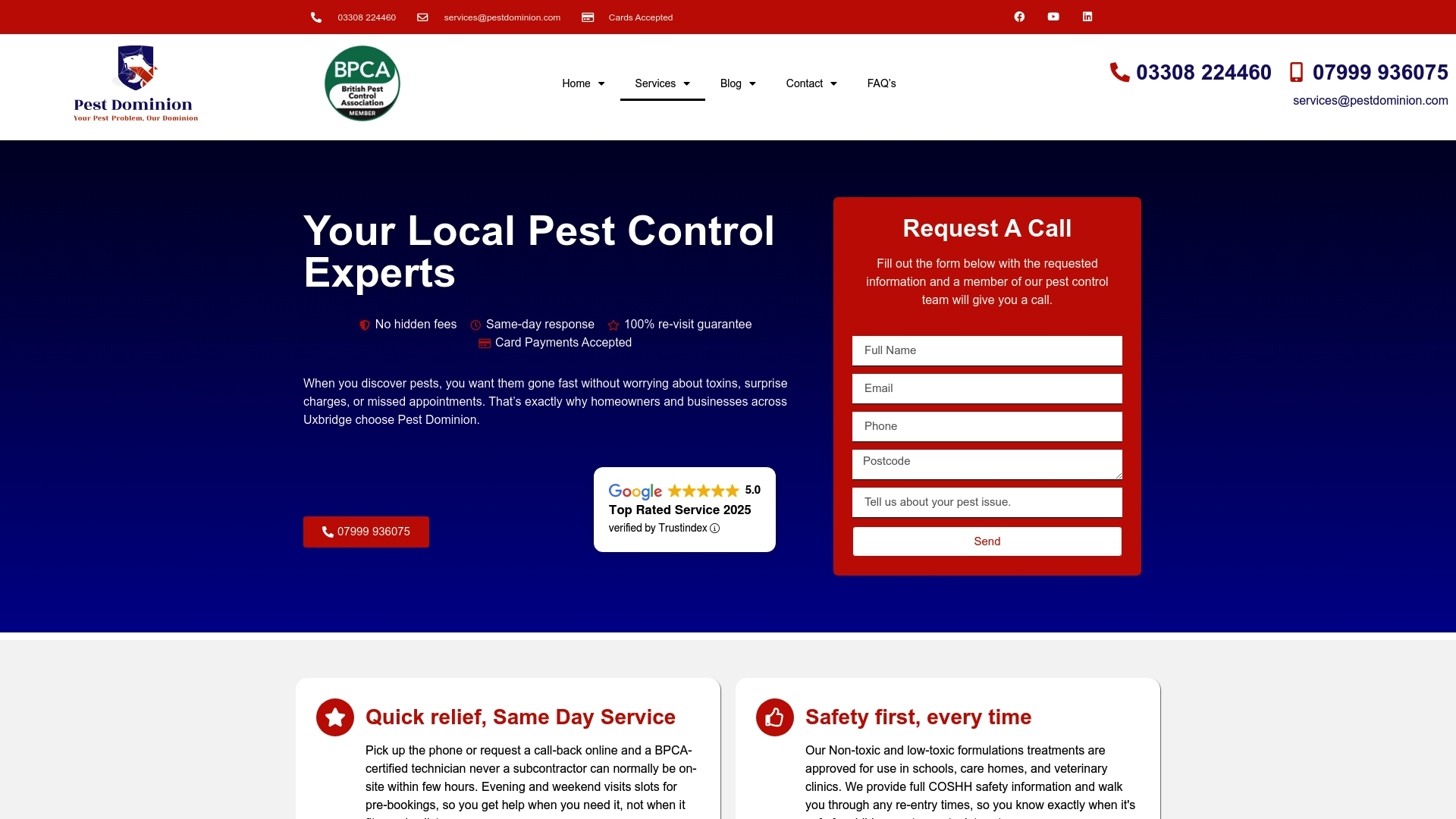Did you know a single wasp nest can shelter up to 5,000 wasps by late summer? These swarming insects do more than cause a nuisance. Left unchecked, their colonies can threaten safety and disrupt outdoor living. Understanding how wasp nests form and why safe removal matters helps protect your family, pets, and property from painful stings and unexpected infestations.
Table of Contents
- What Is Wasp Nest Removal?
- Common Types Of Wasp Nests In The UK
- How Professional Wasp Nest Removal Works
- Risks And Dangers Of Diy Nest Removal
- Legal, Safety, And Cost Considerations
Key Takeaways
| Point | Details |
|---|---|
| Importance of Professional Removal | Wasp nests can contain up to 5,000 wasps, making expert intervention crucial for safety and effective extermination. |
| Risks of DIY Removal | Attempting to remove a wasp nest without assistance poses significant dangers, including aggressive attacks and potential allergic reactions. |
| Understanding Nesting Habits | Familiarity with different wasp species and their nesting preferences is essential for effective pest management strategies. |
| Legal and Safety Considerations | Property owners must adhere to local regulations and safety standards when handling wasp nest removal. |
What Is Wasp Nest Removal?
Wasp nest removal is a specialised pest control process designed to safely eliminate wasp colonies from residential and commercial properties. According to research from local pest management sources, these nests can harbour up to 5,000 individual wasps by late summer, making professional intervention critical. The process involves strategic identification and targeted treatment of wasp habitats, which are commonly found in diverse locations such as soil banks, roof spaces, tree cavities, and wall openings.
Nest removal requires expert techniques that go beyond simple extermination. Professionals conduct a comprehensive assessment to locate the nest, determine the species of wasps, and implement a safe removal strategy. Keeping Wasps Away requires understanding their typical nesting patterns and potential entry points into buildings.
The removal process typically involves several key steps:
- Precise nest location identification
- Species determination
- Assessment of nest size and colony population
- Safe chemical treatment or physical removal
- Prevention of future nesting
Professional pest controllers use specialised protective equipment and targeted treatments to ensure complete colony elimination while minimising risks to residents and the surrounding environment.
Common Types of Wasp Nests in the UK
The United Kingdom hosts several distinct wasp species that create unique nesting habitats across residential and natural environments. According to research from the Woodland Trust, Common Wasps (Vespula vulgaris) are particularly prevalent, constructing intricate nests in diverse locations including house gaps, roof spaces, wall cavities, hollow trees, and attics. These nests are remarkable engineering feats, crafted from chewed wood pulp that forms a distinctive papery substance.
Three primary wasp species dominate the UK landscape: the Common Wasp (Vespula vulgaris), the German Wasp (Vespula germanica), and the Tree Wasp (Dolichovespula sylvestris). Wasp & Hornet Treatment Guide provides deeper insights into these species and their nesting behaviours. Each species demonstrates unique nesting preferences:
Here’s a summary of key differences between the main wasp species and their nesting habits in the UK:
| Wasp Species | Common Nest Locations | Distinctive Features |
|---|---|---|
| Common Wasp | Underground Building cavities | Papery nests Large colonies |
| German Wasp | Similar to Common Wasp | Facial black dots Aggressive |
| Tree Wasp | Trees Aerial sites Underground | Smaller nests Prefers trees |
- Common Wasp: Nests in underground locations and building cavities
- German Wasp: Similar nesting habits to Common Wasps
- Tree Wasp: Builds nests in trees, aerial sites, and occasionally underground
Understanding these nesting patterns is crucial for effective pest management and safe removal strategies. Wasps select nesting sites that offer protection, warmth, and proximity to food sources, making residential and commercial properties attractive locations for their colonies.

How Professional Wasp Nest Removal Works
Professional wasp nest removal is a sophisticated process that requires expert knowledge, specialised equipment, and precise techniques to safely eliminate potentially dangerous wasp colonies. According to local environmental health sources, these nests can contain up to 5,000 individual wasps by late summer, making professional intervention critical for protecting residential and commercial properties.
The removal process typically follows a structured approach that prioritises safety and complete colony elimination. Wasp Nest Removal Near You offers insights into the comprehensive strategy professionals employ. The key stages include:
- Initial Inspection: Thoroughly locating the nest and assessing its size, species, and accessibility
- Risk Assessment: Evaluating potential dangers and determining the most appropriate removal method
- Protection Preparation: Wearing specialised protective equipment to prevent wasp stings
- Targeted Treatment: Using professional-grade insecticides or removal techniques specific to the nest’s location
- Colony Elimination: Ensuring complete destruction of the nest and preventing future reinfestation
Professional pest controllers employ a combination of chemical treatments and physical removal techniques, depending on the nest’s location and the specific wasp species.
This approach ensures not just immediate nest removal, but also long-term protection against future wasp infestations, keeping properties safe and wasp-free.
Risks and Dangers of DIY Nest Removal
Attempting to remove a wasp nest without professional assistance can be an extremely dangerous endeavour. According to local environmental health research, wasps become extraordinarily aggressive when their nest is disturbed, presenting significant health risks to untrained individuals who attempt removal. The potential for multiple painful and potentially dangerous stings makes DIY nest removal a hazardous undertaking.
Serious risks associated with amateur wasp nest removal include:
- Immediate physical danger from aggressive wasp attacks
- Potential allergic reactions to multiple wasp stings
- Risk of falling from heights when attempting to reach difficult nest locations
- Incomplete nest removal leading to continued colony threat
- Potential property damage from improper removal techniques
Advice for Controlling Wasps highlights the importance of professional intervention. Wasps can perceive any disturbance as a threat, triggering a coordinated defensive response where hundreds of wasps simultaneously attack the perceived intruder. Individuals with known wasp allergies are at even greater risk, as a single sting could trigger a potentially life-threatening anaphylactic reaction.
Professional pest controllers are equipped with specialised protective gear, understanding of wasp behaviour, and precise removal techniques that minimise risks and ensure complete nest elimination. The small investment in professional services far outweighs the potential medical and personal risks of attempting to remove a wasp nest independently.
Legal, Safety, and Cost Considerations
Wasp nest removal involves several critical considerations that extend beyond simple pest control. According to local environmental health guidance, confirming the actual presence of wasps is crucial before engaging any removal services, as misidentification with bees can lead to unnecessary complications and potential legal issues.
Key considerations for responsible wasp nest management include:
- Legal obligations for property owners
- Potential environmental protection regulations
- Health and safety compliance requirements
- Professional certification and insurance standards
- Ethical and humane removal practices
Wasp Nest Removal highlights the importance of understanding local regulations and professional standards. Costs for professional removal can vary significantly depending on nest location, size, and accessibility. Factors influencing pricing include:
- Nest complexity and size
- Location difficulty (ground level vs. roof spaces)
- Number of treatment sessions required
- Geographic region and local market rates
- Specific pest control company’s expertise
Professional services not only provide safe and efficient nest removal but also offer long-term prevention strategies. The investment in professional pest control ensures comprehensive management, minimising risks to personal safety, property integrity, and potential legal complications associated with amateur removal attempts.
Experience Safe and Effective Wasp Nest Removal with Pest Dominion Limited
Dealing with a wasp nest can be stressful and dangerous. The article outlines key concerns like aggressive wasp behaviour, risks of DIY removal, and the need for professional techniques to ensure complete and safe elimination. At Pest Dominion Limited, we understand these challenges and provide expert wasp nest removal services designed to protect your family, employees, and property.
Our local specialists use industry-leading methods compliant with health and safety standards to manage wasp infestations in Slough and surrounding areas. We offer thorough inspections, tailored treatments, and ongoing prevention advice to give you peace of mind. Discover how our professional approach makes pest control straightforward and reliable by visiting our Wasp Nest Removal page.

Protect yourself and your loved ones today by choosing Pest Dominion Limited. Act now to avoid the dangers of amateur wasp nest removal and ensure a swift resolution. For trusted expertise and clear, transparent service, learn more at Pest Dominion Limited and get in touch for a prompt consultation.
Frequently Asked Questions
What is wasp nest removal?
Wasp nest removal is a specialised pest control process that safely eliminates wasp colonies from properties, involving identification, assessment, and strategic treatment of their nesting sites.
What are the common types of wasp nests?
The most common wasp nests include those of the Common Wasp, German Wasp, and Tree Wasp, each with unique nesting preferences such as underground locations, building cavities, or trees.
What are the risks of DIY wasp nest removal?
DIY wasp nest removal can be dangerous due to aggressive wasp attacks, potential allergic reactions, and the risk of falling. It can also lead to incomplete removal, creating ongoing threats.
How do professionals remove wasp nests?
Professionals follow a structured approach that includes inspection, risk assessment, protective preparation, targeted treatment, and complete colony elimination to ensure safety and effectiveness.

